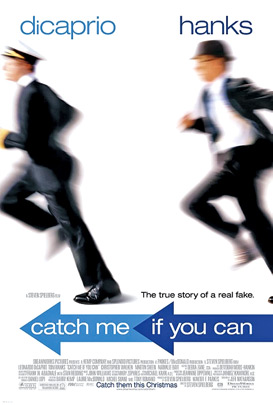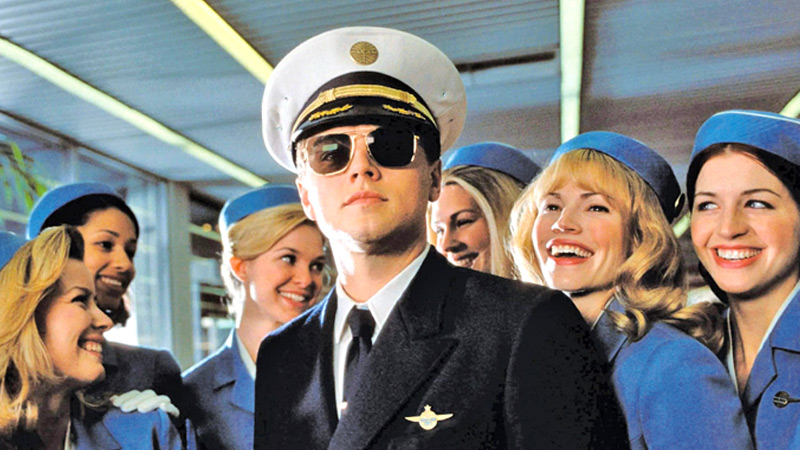“Catch Me If You Can,” a 2002 American biographical crime comedy-drama directed by Steven Spielberg, captivated audiences with its gripping tale of a young con artist and the relentless FBI agent pursuing him. Starring Leonardo DiCaprio and Tom Hanks in lead roles, the film brought to life the incredible true story of Frank Abagnale Jr., a master of deception who successfully executed cons worth millions before his 19th birthday. This article delves into the fascinating behind-the-scenes details of the film’s production, casting choices, and critical reception.
The Journey to the Big Screen
 The journey of adapting Frank Abagnale Jr.’s semi-autobiographical book began in 1997 when Spielberg’s DreamWorks acquired the film rights. Several renowned directors, including David Fincher, Gore Verbinski, Lasse Hallström, Miloš Forman, and Cameron Crowe, were considered to helm the project. Ultimately, Spielberg, drawn to the material, decided to direct the film himself. The screenplay by Jeff Nathanson brought Abagnale’s captivating story to life, portraying his audacious cons, including posing as a Pan American World Airways pilot, a Georgia doctor, and a Louisiana parish prosecutor.
The journey of adapting Frank Abagnale Jr.’s semi-autobiographical book began in 1997 when Spielberg’s DreamWorks acquired the film rights. Several renowned directors, including David Fincher, Gore Verbinski, Lasse Hallström, Miloš Forman, and Cameron Crowe, were considered to helm the project. Ultimately, Spielberg, drawn to the material, decided to direct the film himself. The screenplay by Jeff Nathanson brought Abagnale’s captivating story to life, portraying his audacious cons, including posing as a Pan American World Airways pilot, a Georgia doctor, and a Louisiana parish prosecutor.
Casting Challenges and Triumphs
The casting process for “Catch Me If You Can” involved a series of changes and negotiations. James Gandolfini, Ed Harris, and Chloë Sevigny were initially cast by Verbinski, but due to scheduling conflicts and directorial changes, Tom Hanks replaced Gandolfini, and Amy Adams stepped into the role originally intended for Sevigny. Christopher Walken, Martin Sheen, and Nathalie Baye also joined the cast, contributing to the film’s stellar ensemble.
The Filming Odyssey
Principal photography for the film took place from February to May 2002 in various locations, including Los Angeles, New York City, Quebec City, and Montreal. Spielberg’s decision to direct resulted in the shelving of other projects, emphasizing the director’s commitment to bringing Abagnale’s story to life. The filming process was both intensive and efficient, with 147 locations captured in just 52 days. DiCaprio reflected on the rapid pace, noting that scenes which were anticipated to take days were completed in mere afternoons.
The Critical Acclaim
Upon its release on December 25, 2002, “Catch Me If You Can” received positive reviews from critics. The film’s Rotten Tomatoes rating of 96 percent and Metacritic score of 75 indicated widespread acclaim. Audiences polled by CinemaScore gave it an “A-” grade. DiCaprio’s performance, in particular, drew praise, with Roger Ebert commending his portrayal of Abagnale as a “real-life wunderkind con artist.” The film’s stylish cinematography, smart performances, and brisk tempo were lauded, showcasing Spielberg’s ability to craft an effortlessly watchable and entertaining film.
“Catch Me If You Can” stands as a testament to the collaborative efforts of a talented cast and crew under Spielberg’s direction.
The film not only brought a captivating true story to the big screen but also showcased the versatility of Leonardo DiCaprio and the directorial finesse of Steven Spielberg. With its blend of humour, suspense, and charm, the film continues to be celebrated for its stylish execution and compelling storytelling, making it a timeless addition to the world of cinema.




